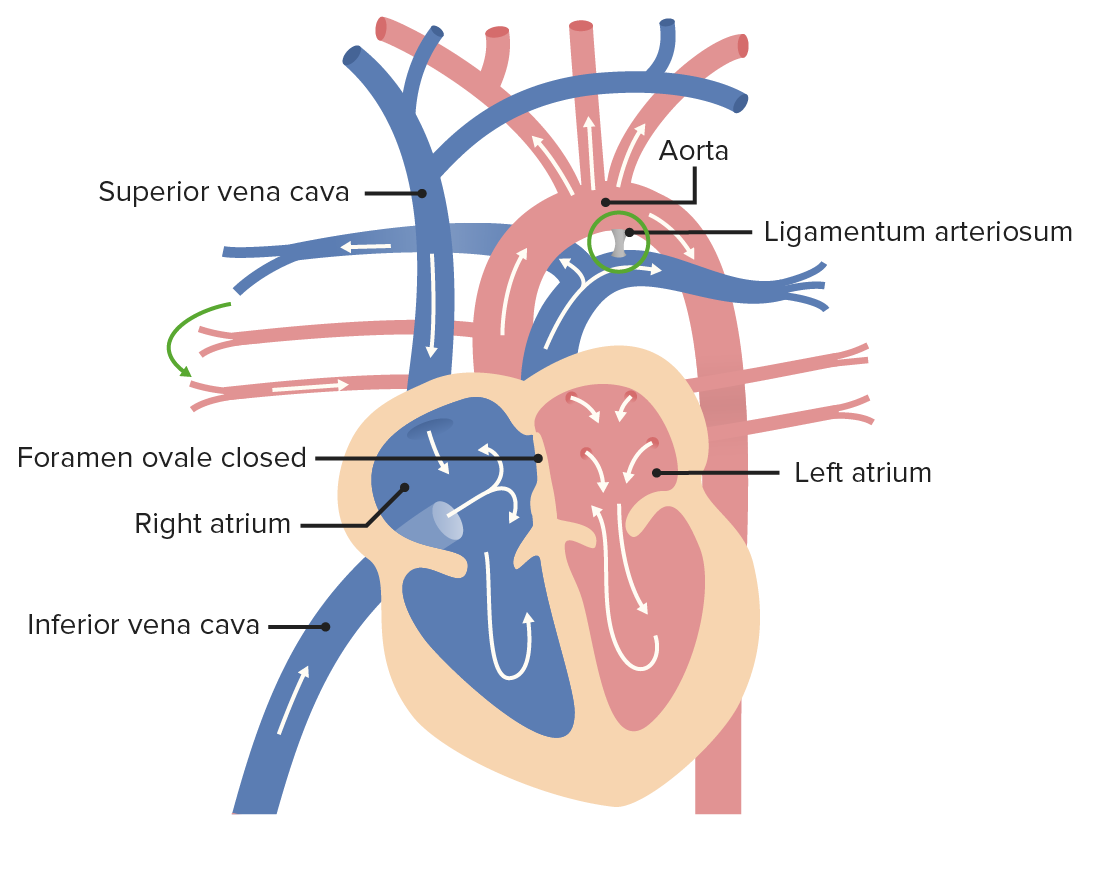Playlist
Show Playlist
Hide Playlist
Formation of the Outflow Tracts
-
Slides 06-31 Formation of the Outflow Tracts.pdf
-
Download Lecture Overview
00:01 Hello and welcome to the talk on how the bulbous cordis is going to become the two separate outflow tracts of the heart, the aorta and pulmonary trunk. 00:10 Now, the easiest way to conceptualize this is the same way we conceptualize the atrioventricular canals splitting. 00:16 Essentially, we have a common chamber that's receiving blood from both the right and left ventricles that's being pumped, and to separate it's going to just pinch together. 00:26 And in this case, the portion of the bulbous cordis that's pinching together is both the conus cordis, the smooth portion of the outflow, and the truncus arteriosus, the part that continues up to the proximal aorta and pulmonary trunk. 00:40 So the ridges that close that common chamber are called conotruncal ridges and the conotruncal ridges will separate that common tract into an aorta and the pulmonary trunk. 00:51 But there's a problem, and the problem is the left ventricle is directly connected to the pulmonary trunk and the right ventricle is directly connected to the aorta if we just go straight up out to the heart. 01:06 So these outflow tracts not only have to separate, they have to spiral so that the right ventricle winds up next to the pulmonary trunk and the left ventricle winds up going to the aorta. 01:18 So as these two tracts separate into an aorta and a pulmonary trunk there's actually gonna be a little bit of a spiral inside as those conotruncal ridges form. 01:28 Now as that spiraling happens, the conotruncal ridges enlarge and have little swellings inside their walls that then hollow out and those hollowed out spaces are gonna form the semilunar cusps of the aortic valve and the semilunar valve. 01:45 These valve cusps are continuous with the endocardium of the heart and the lining of the interior and all the blood vessels of the body. 01:54 Now, this image is a little bit daunting so we're gonna take a moment and walk our way through it. 02:00 The conotruncal ridges are shown in green and yellow and what we can see here is that we have the left ventricle receiving blood through the mitral orifice, the right ventricles receiving blood through the tricuspid orifice and at that point, contraction of the ventricles is going to propel blood up into both the aorta and the pulmonary trunk. 02:23 What we want to have happened is for the blood from the right ventricle to spiral up into the pulmonary trunk and blood from left ventricle to spiral up into the aorta. 02:33 So the green and yellow conotruncal ridges are growing together in a spiral fashion. 02:39 Let's move to the next image which is a bit simpler and you can see how those ridges coming together have formed a continuous septum and have separated the two outflow tracts. 02:49 But there's a problem, the problem is the right and left ventricles are still in contact with each other. 02:56 This problem was resolved when the endocardial cushions and the membranous portion of the interior ventricular septum grow together and actually grow upward to fuse with the conotruncal ridges. 03:09 So now, we're left with something like the middle picture where we've completely separated the right and left ventricles, we've completely separated the aorta from the pulmonary trunk. 03:21 And one thing I want you to note is that both the endocardial cushions and the conotruncal ridges come from neurocrest cells, and if you have failure of neurocrest cell migration, a very, very common problem is going to be heart defects especially defects involving the endocardial cushions and the conotruncal ridges. 03:41 So if we take a look at the picture on the lower right, we see how everything ought to wind up the outflow tracts spiral connecting the left ventricle to the aorta, connecting the pulmonary trunk to the right ventricle and no mixing of blood between the two.
About the Lecture
The lecture Formation of the Outflow Tracts by Peter Ward, PhD is from the course Development of Thoracic Region and Vasculature.
Included Quiz Questions
The conotruncal ridges that separate the conus cordis and truncus arteriosus are derived from which of the following?
- Neural crest
- Lateral plate mesoderm
- Cardiogenic mesoderm
- Intermediate mesoderm
- Endoderm
The swellings of the conotruncal ridges will form the semilunar valves, which are continuous with which layer of the heart?
- Endocardium
- Inner pericardium
- Outer pericardium
- Epicardium
- Myocardium
Customer reviews
5,0 of 5 stars
| 5 Stars |
|
1 |
| 4 Stars |
|
0 |
| 3 Stars |
|
0 |
| 2 Stars |
|
0 |
| 1 Star |
|
0 |
Those embryology videos manage to be concise whitout butchering the major axis of this subject, lecturio is making my life easier.




